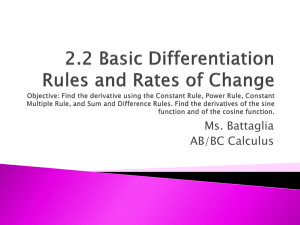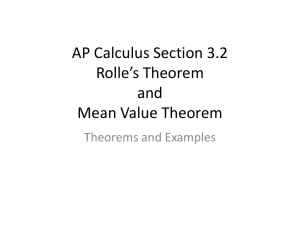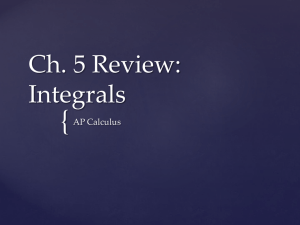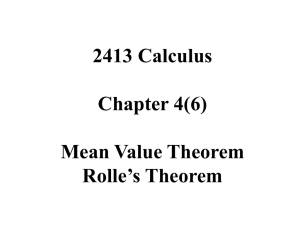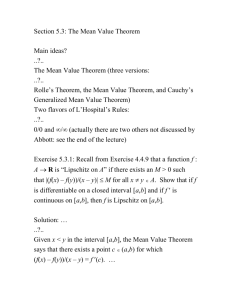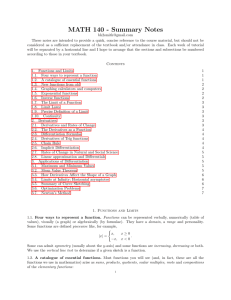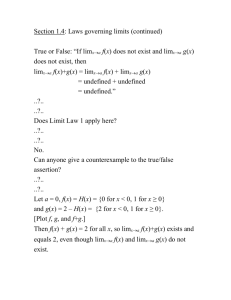The derivative.
advertisement
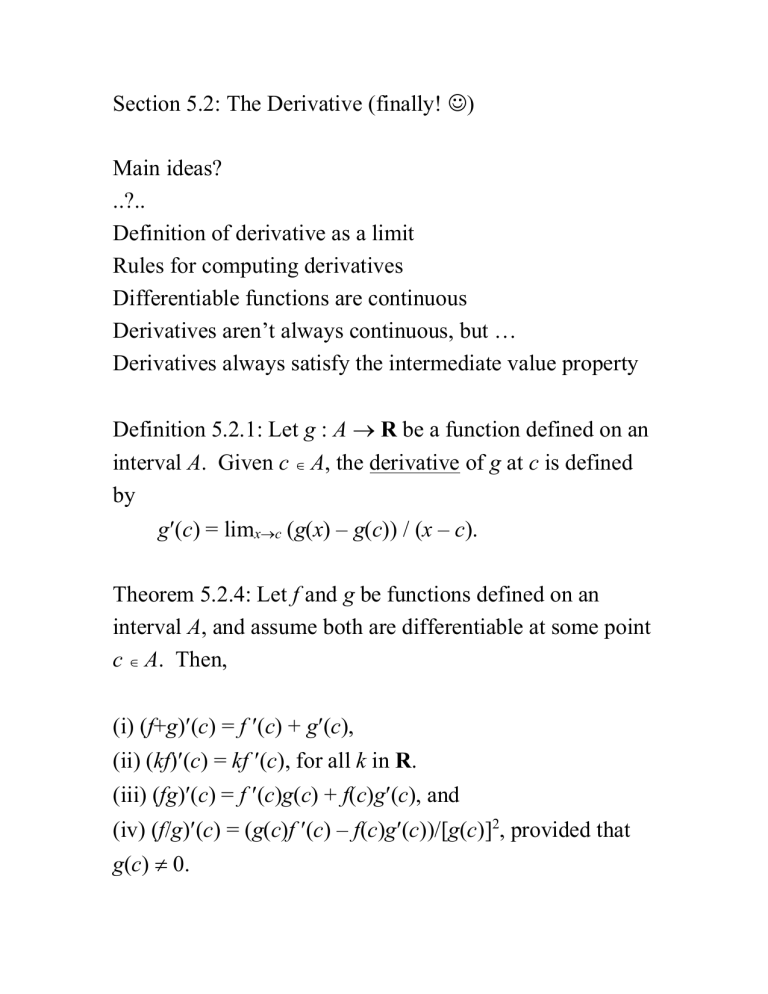
Section 5.2: The Derivative (finally! )
Main ideas?
..?..
Definition of derivative as a limit
Rules for computing derivatives
Differentiable functions are continuous
Derivatives aren’t always continuous, but …
Derivatives always satisfy the intermediate value property
Definition 5.2.1: Let g : A R be a function defined on an
interval A. Given c A, the derivative of g at c is defined
by
g(c) = limxc (g(x) – g(c)) / (x – c).
Theorem 5.2.4: Let f and g be functions defined on an
interval A, and assume both are differentiable at some point
c A. Then,
(i) (f+g)(c) = f (c) + g(c),
(ii) (kf)(c) = kf (c), for all k in R.
(iii) (fg)(c) = f (c)g(c) + f(c)g(c), and
(iv) (f/g)(c) = (g(c)f (c) – f(c)g(c))/[g(c)]2, provided that
g(c) 0.
Exercise 5.2.1: Supply proofs for parts (i) and (ii) of
Theorem 5.2.4.
(i) First we rewrite the difference quotient as
[(f+g)(x) – (f+g)(c)]/[x – c]
= [f(x) + g(x) – f(c) – g(c)]/[x – c]
= [f(x) – f(c)]/[x – c] + [g(x) – g(c)]/[x – c]
The fact that f and g are differentiable at c together with the
functional-limit version of the Algebraic Limit Theorem
(Theorem 4.2.4) justifies the conclusion
(f + g)(c) = f (c) + g(c).
(ii) Homework!
Note that if c is an endpoint of the interval A, then g(c) is a
one-sided limit; otherwise g(c) is a two-sided limit.
Theorem 5.2.5 (Chain Rule): Let f : A R and g : B R
satisfy f(A) B so that the composition g f is well-defined
on all of A. If f is differentiable at c A and if g is
differentiable at f(c) B, then g f is differentiable at c
with (g f )(c) = g(f(c)) f (c).
Exercise 5.2.5: Let
{xa sin 1/x
if x 0
ga(x) = {
{0
if x = 0
Find a particular (potentially noninteger) value for a so that
(a) ga is differentiable on [0,) but such that ga is
unbounded on [0,1] (implying that ga is not continuous on
[0,1], by virtue of …
..?..
Theorem 4.4.2: a continuous function on a compact set is
bounded)
(b) ga is differentiable on [0,) with ga continuous but not
differentiable at zero.
(c) ga is differentiable on [0,) and ga is differentiable on
[0,), but such that ga is not continuous at zero.
(a) With regards to the existence of ga(x) at x = 0 we see
that
ga(0) = limx0 [ga(x) – ga(0)]/[x – 0]
= limx0 [xa sin 1/x – 0]/[x – 0] = limx0 xa–1 sin 1/x = 0
as long as …
..?..
a > 1. For x 0, ga(x) always exists, and using the
standard rules of differentiation we get
ga(x) = – xa–2 cos 1/x + axa–1 sin 1/x.
Setting 1 < a < 2 makes xa–2 cos(1/x) unbounded near zero
while axa–1 sin 1/x stays bounded, so that ga(x) is
unbounded near 0, as was desired.
(b) For ga(x) to be continuous we need
limx0 ga(x) = ga(0) = 0
and, since
ga(x) = – xa–2 cos 1/x + axa–1 sin 1/x for x 0,
we see that this happens as long as …
..?..
a > 2. For the second derivative ga(0) we consider the
limit
ga(0) = limx0 ga(x)/x
= limx0 (1/x) ( – xa–2 cos 1/x + axa–1 sin 1/x)
= limx0 ( – xa–3 cos 1/x + axa–2 sin 1/x))
which exists if and only if …
..?..
a > 3. That is, for ga(0) to be undefined, we need …
..?..
a 3.
Thus setting 2 < a 3 gives us a function of the desired
kind.
(c) From (b) we see that choosing a > 3 makes ga
differentiable at zero. Away from zero we get
ga(x) = – xa–4 sin 1/x – (2a–2)xa–3 cos 1/x
+ a(a–1)xa–2 sin 1/x,
which fails to be continuous at zero when …
..?..
a 4. Setting 3 < a 4 gives the desired function.
Theorem 5.2.6 (Interior Extremum Theorem): Let f be
differentiable on an open interval (a,b). If f attains a
maximum value at some point c (a,b) (i.e., f(c) f(x) for
all x (a,b)), then f (c) = 0. The same is true if f(c) is a
minimum value.
Theorem 5.2.7 (Darboux’s Theorem): If f is differentiable
on the interval [a,b], and if satisfies f (a) < < f (b) (or
f (a) > > f (b)), then there exists a point c (a,b) where
f (c) = .
Special case: If g is differentiable on the interval [a,b], and
if f (a) < 0 < f (b) (or f (a) > 0 > f (b)), then there exists a
point c (a,b) where f (c) = 0.
This special case arises from Abbott’s strategy for proving
Theorem 5.2.7. Specifically, he introduces a new function
g(x) := f(x) – x on [a,b]. Notice that g is differentiable on
[a,b] with g(x) = f (x) – . In terms of g, our hypothesis
states that g(a) < 0 < g(b), and we hope to show that g(c)
= 0 for some c (a,b).
Exercise 5.2.6(a): Assume that g is differentiable on [a,b]
and satisfies g(a) < 0 < g(b). Show that there exists a
point x (a,b) where g(x) < g(a), and a point y (a,b)
where g(y) < g(b).
First let’s prove that there exists x in (a,b) where g(x) <
g(a). Let (xn) be a sequence in (a,b) satisfying (xn) a.
Then by the definition of the derivative and the sequential
characterization of limits we have
g(a) = limn [g(xn) – g(a)]/[xn – a] < 0.
The denominator is always positive. If the numerator were
always positive then the Order Limit Theorem would imply
g(a) 0. Because we know this is not the case, we may
conclude that the numerator is eventually negative and thus
g(xn) < g(a) for some xn near a.
The proof that there exists y in (a,b) where g(y) < g(b) is
similar [have the students walk through it].
Exercise 5.2.6(b): Now complete the proof of Darboux’s
Theorem started earlier.
[I didn’t cover this in class on the 9th, and I won’t have time
to cover it on the 13th, so here’s what I would have said if
I’d had more time:]
We must show that g(c) = 0 for some c (a,b). Because g
is differentiable on the compact set [a,b] it must also be
continuous here, and so by the Extreme Value Theorem
(Theorem 4.4.3), g attains a minimum at a point c [a,b].
From our work in (a) we know that the minimum of g is
neither g(a) nor g(b), and therefore c (a,b). Finally, the
Interior Extremum Theorem (Theorem 5.2.6) allows us to
conclude g(c)=0.
To prove Darboux’s theorem we just observe that g(c)=0 is
equivalent to the desired conclusion f (c)= (check: g(x) =
f(x) – x, so g(x) = f (x) – and g(c) = f (c) – ).


